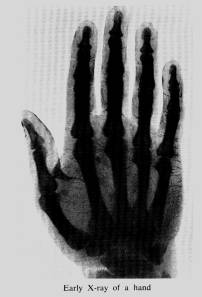
Ršntgen's work on cathode rays led him to the discovery of a new kind of ray. On the evening of November 8, 1895 at the University of Wźrzburg Ršntgen's attention was drawn to a glowing fluorescent screen on a nearby table. He immediately determined that the fluorescence was caused by invisible rays originating from a glass tube, that he was using to study cathode rays. These unknown rays go through the opaque black paper that is wrapped around the tube. He found that if the discharge tube is enclosed in a sealed thick black carton to exclude all light, and if a paper plate was covered on one side with barium platinocyanide, and placed in the path of the rays, it would become fluorescent up to two meters away from the discharge tube. Ršntgen had discovered X-rays. This was an event that instantly revolutionized the field of physics and medicine. Before the discovery on the night of November 8, 1895, Ršntgen had been studying the properties of these rays for two months.
After his discovery, Ršntgen continued experimenting with X-rays. He found that objects of different thicknesses inserted in the path of the rays would show transparency to them when they were recorded on a photographic plate. For instance, when he kept his wifeŐs hand still for some time in the path of the rays over a photographic plate, he found that after development, an image of his wifeŐs hand was shown. The dark shadows from her bones and from her ring that she was wearing, surrounded by flesh gave off a fainter shadow. The flesh gives off a fainter shadow than bones because they were more porous, and less dense.
HAND PICTURE
This was the
first "roentgenogram" ever taken.
http://www.quietgod.com/hypertext/contribution/essays/x-ray_photography.html
Ršntgen later proved that new rays are produces by the impact of cathode rays on a material object. When these unknown rays were first discovered, their natural history was not known, and that is the reason why they were called X-rays. Later, Max von Laue discovered that X-rays differ only slightly from light by a higher vibration frequency.
For his discovery of X-rays, Ršntgen received the first Nobel Prize in physics in 1901. When later asked what his thoughts were at the moment of his discovery, he replied,
ADVANCEMENTS
and IMPORTANCES
FUN FACTS AND PICTURES